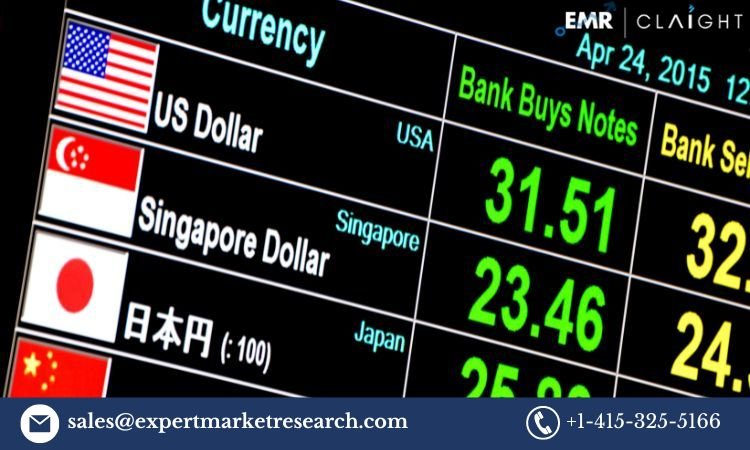The Foreign Exchange Market Size is one of the largest and most liquid financial markets in the world, where currencies are bought and sold at competitive prices. With a daily turnover surpassing USD 6.6 trillion, the forex market influences global trade, investments, and economies. This article will explore the key benefits, market developments, driving factors, the impact of COVID-19, and the overall market outlook. We will also examine various market segments, challenges, and opportunities that investors and stakeholders should be aware of. The global foreign exchange market is expected to grow from USD 812.14 billion in 2024 to USD 1,476.12 billion by 2034, at a Compound Annual Growth Rate (CAGR) of 6.8%.
Market Overview
The Foreign Exchange Market is a decentralized global market for trading currencies. It operates 24 hours a day, five days a week, allowing participants to trade major, minor, and exotic currency pairs. Key participants in the forex market include commercial banks, central banks, hedge funds, investment firms, multinational corporations, and retail traders. The largest currency pairs by trading volume include the EUR/USD, GBP/USD, and USD/JPY, and major players engage in currency speculation, hedging, and arbitrage to take advantage of price fluctuations.
The key factors influencing the forex market include interest rates, economic indicators, geopolitical events, and market sentiment. These factors determine the supply and demand of various currencies, ultimately affecting exchange rates.
Key Benefits of the Foreign Exchange Market
The foreign exchange market offers several unique benefits for investors, businesses, and economies. These benefits include:
-
High Liquidity: With a daily turnover exceeding USD 6 trillion, the forex market ensures that trades can be executed quickly, at any given time, without significant price fluctuations.
-
Accessibility: The forex market is accessible to retail traders, institutions, and corporate clients alike. A variety of platforms and brokers make trading easy for participants of all experience levels.
-
Diversification: Investors can diversify their portfolios by including foreign currencies, which provides exposure to global financial conditions and can help reduce risk.
-
Leverage Opportunities: Forex trading allows for significant leverage, enabling traders to amplify potential returns. However, this also means the potential for greater risks.
-
Global Impact: The forex market is a critical component of global economic stability, impacting international trade, capital flows, and investment decisions.
Key Industry Developments
The forex market continues to evolve, driven by technological advances, regulatory changes, and new market trends. Some of the notable developments in the industry include:
-
Technological Advancements: Algorithmic trading, Artificial Intelligence (AI), and Machine Learning (ML) are becoming increasingly prevalent in the forex market. These technologies allow for faster, more efficient decision-making, and provide real-time analysis for traders to make informed decisions.
-
Rise of Retail Forex Trading: The growth of retail forex brokers and easy-to-use online trading platforms has allowed retail traders to participate more actively in currency markets. This has democratized access to currency trading.
-
Central Bank Digital Currencies (CBDCs): Central banks across the globe are exploring the creation of digital currencies, which could reshape the foreign exchange landscape and create new opportunities for trade.
-
Increased Regulatory Oversight: Governments and regulators are becoming more involved in monitoring the forex market to ensure transparency, reduce risks, and combat fraudulent activities such as market manipulation.
Driving Factors
Several factors contribute to the growth and continued expansion of the forex market:
-
Globalization of Trade: As more countries engage in international trade, the demand for foreign currencies rises, providing greater opportunities for currency exchange.
-
Monetary Policy and Interest Rates: Central banks, through their monetary policies and interest rate decisions, significantly impact currency prices. Investors closely follow changes in interest rates to gauge the likely movement of currencies.
-
Technological Innovation: The development of more sophisticated trading platforms, real-time data analysis, and AI-driven tools allows for increased market efficiency, improved access to liquidity, and more informed trading decisions.
-
Geopolitical Events: Events such as elections, conflicts, and policy changes often lead to fluctuations in currency prices, creating trading opportunities for market participants.
Impact of COVID-19 on the Forex Market
The COVID-19 pandemic brought unprecedented challenges to global markets, including the forex market. The impact of the pandemic can be seen in the following ways:
-
Increased Volatility: The uncertainty caused by the pandemic led to heightened market volatility, with currencies fluctuating sharply in response to the pandemic’s effects on global economies.
-
Economic Recession: Many countries experienced economic downturns due to lockdowns and restrictions, which resulted in central banks implementing aggressive monetary policies like interest rate cuts and asset purchases to support their economies.
-
Shifts in Trading Behavior: Investors sought safe-haven assets like the US Dollar and Japanese Yen as a hedge against the economic uncertainties of the pandemic. At the same time, emerging market currencies suffered.
-
Interest Rate Cuts and Stimulus Measures: In response to the pandemic, central banks across the world cut interest rates and implemented stimulus packages, which had a direct effect on forex market dynamics.
While the forex market was initially affected by the economic uncertainties of the pandemic, it has gradually rebounded as countries and economies adjust to the new global environment.
Restraining Factors
Despite its vast potential, the forex market faces certain restraints that can affect its growth:
-
Market Manipulation and Fraud: The forex market is often vulnerable to market manipulation, including practices such as “pump and dump” schemes or insider trading. Regulatory measures are being introduced to curb these practices, but challenges remain.
-
Complexity of Trading: Forex trading can be challenging for beginners, as it requires a good understanding of financial markets, risk management, and technical analysis. This may deter some potential participants from entering the market.
-
Geopolitical Risk: Political instability and tensions between countries, such as trade wars or military conflicts, can create an environment of uncertainty, leading to currency devaluation and reduced trading volume.
Market Segmentation
The forex market can be segmented based on different factors, including trading type, participant type, and geographical region.
-
By Trading Type:
- Spot Trading: The immediate exchange of currencies at the current market price.
- Forward Trading: A contract to buy or sell a currency at a future date at a specified exchange rate.
- Futures Trading: A standardized contract to buy or sell a currency at a future date.
- Options Trading: A contract giving the right, but not the obligation, to buy or sell a currency at a predetermined price before a specific date.
-
By Participant Type:
- Retail Traders: Individual traders participating in the market through brokers.
- Institutional Investors: Hedge funds, pension funds, and other financial institutions that trade large volumes of currencies.
- Banks and Financial Institutions: Commercial and central banks that are heavily involved in the forex market.
-
By Geography:
- North America: The United States is a leading player in the forex market, especially due to the dominance of the US Dollar.
- Europe: The European Union is home to the Euro, one of the most traded currencies.
- Asia-Pacific: Japan, China, and Australia are key players in the forex market due to their strong economies.
Regional Analysis/Insights
The forex market is a global marketplace, with different regions contributing to market growth. North America, Europe, and the Asia-Pacific region are the largest players in terms of trading volume. The US Dollar is the most traded currency, and countries like the United States, Japan, and China have a significant impact on forex market trends.
In emerging markets, such as India and Brazil, forex trading is gaining momentum as more people get access to online trading platforms. Additionally, the growth of the Chinese Yuan (CNY) and the increasing internationalization of the Chinese economy are expected to play a pivotal role in shaping the market.
Major Key Players
Several key players dominate the forex market:
- Barclays Bank Plc
- BNP Paribas
- Citigroup Inc.
- Deutsche Bank AG
- Goldman Sachs
- HSBC Bank plc
- JPMorgan Chase & Co.
- Standard Chartered Group
- State Street Corporation
- XTX Markets Pte Ltd
- Others
Opportunities
-
Technological Integration: With the rise of AI and blockchain technology, forex trading platforms can offer greater efficiency, transparency, and security.
-
Growing Retail Market: The increasing popularity of forex trading among retail investors presents significant growth opportunities.
-
Expansion in Emerging Markets: As emerging economies grow, the demand for forex trading is likely to increase, offering new investment avenues.
Challenges
-
Regulatory Uncertainty: The constantly changing regulatory landscape can create challenges for traders and institutions.
-
Market Risk and Volatility: Currency markets can be highly volatile, posing risks for investors, especially those using high leverage.



